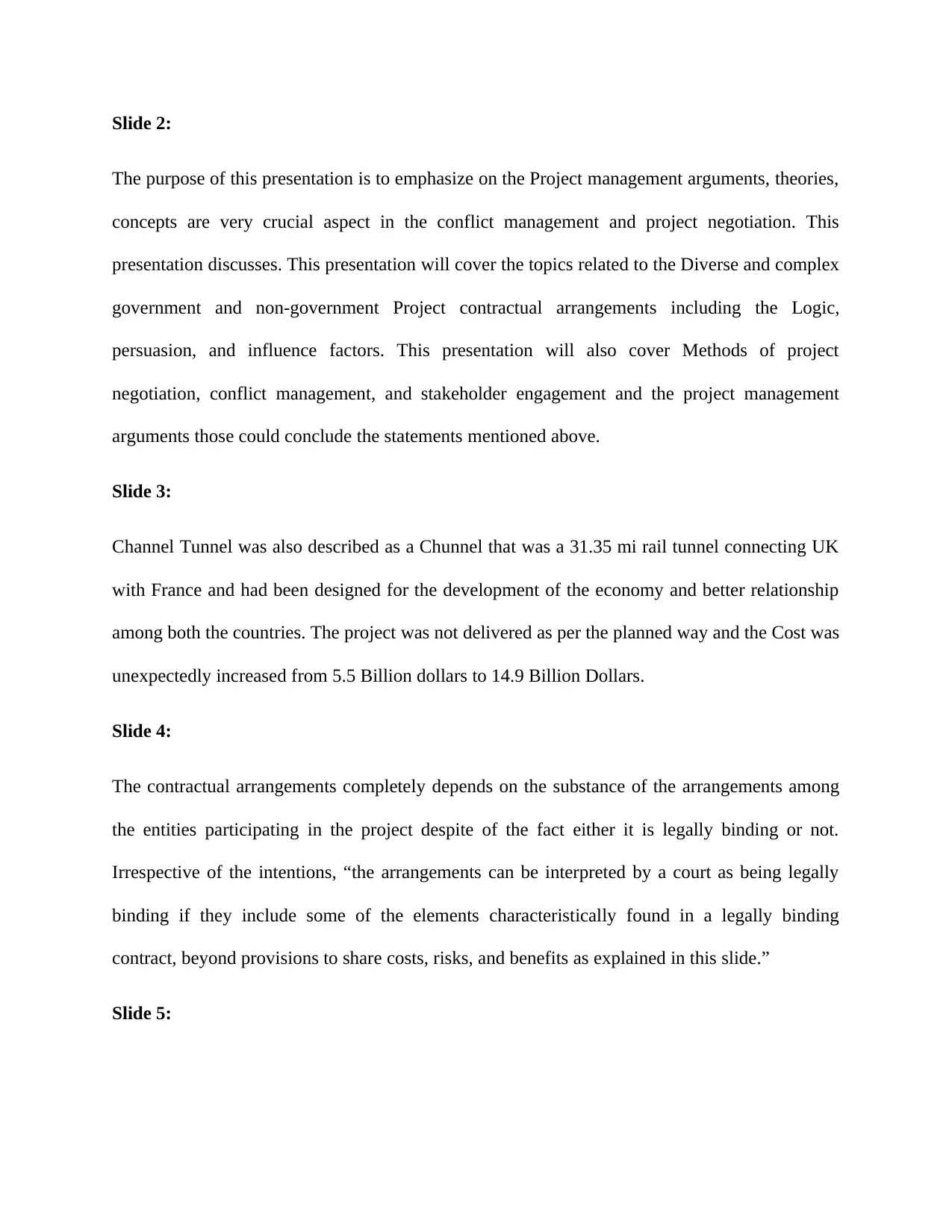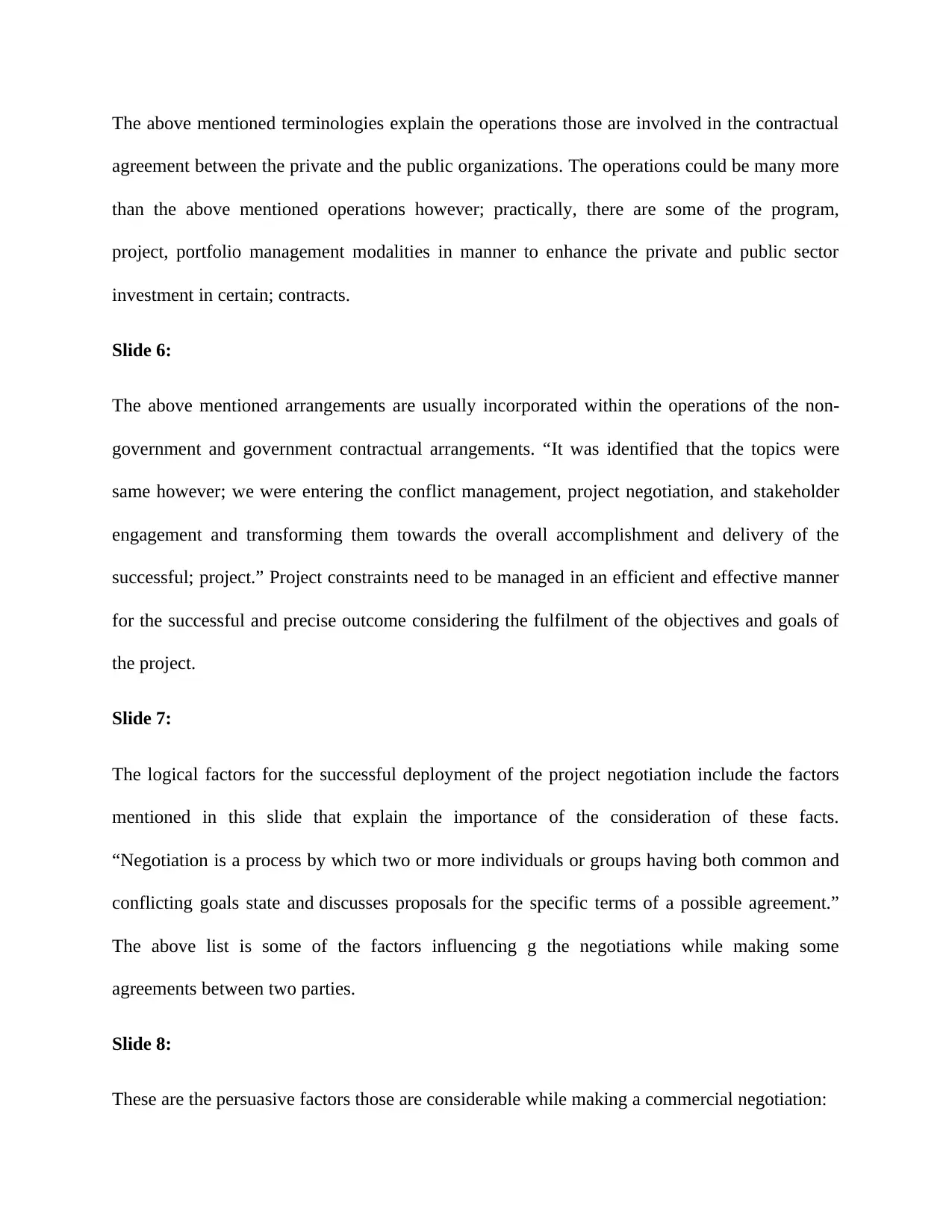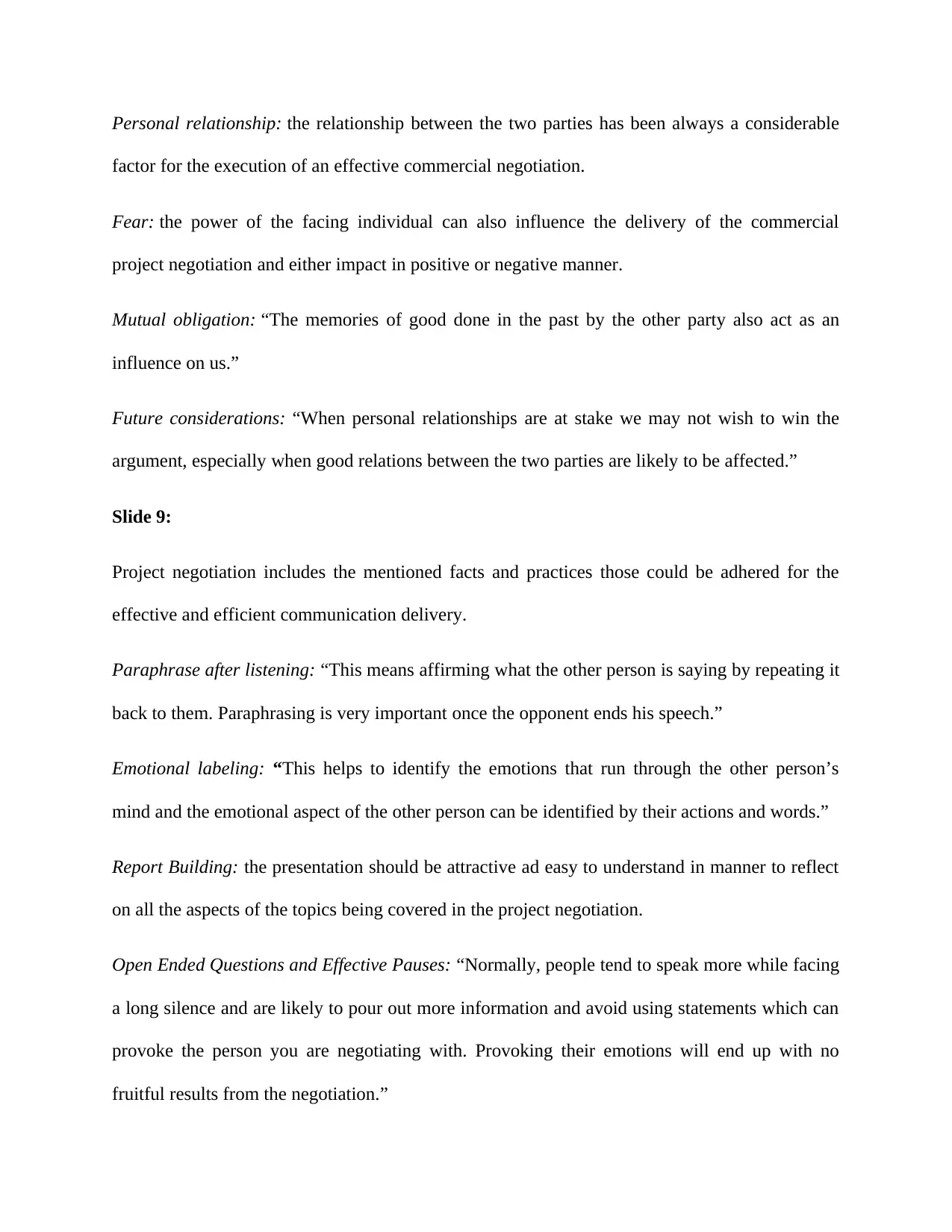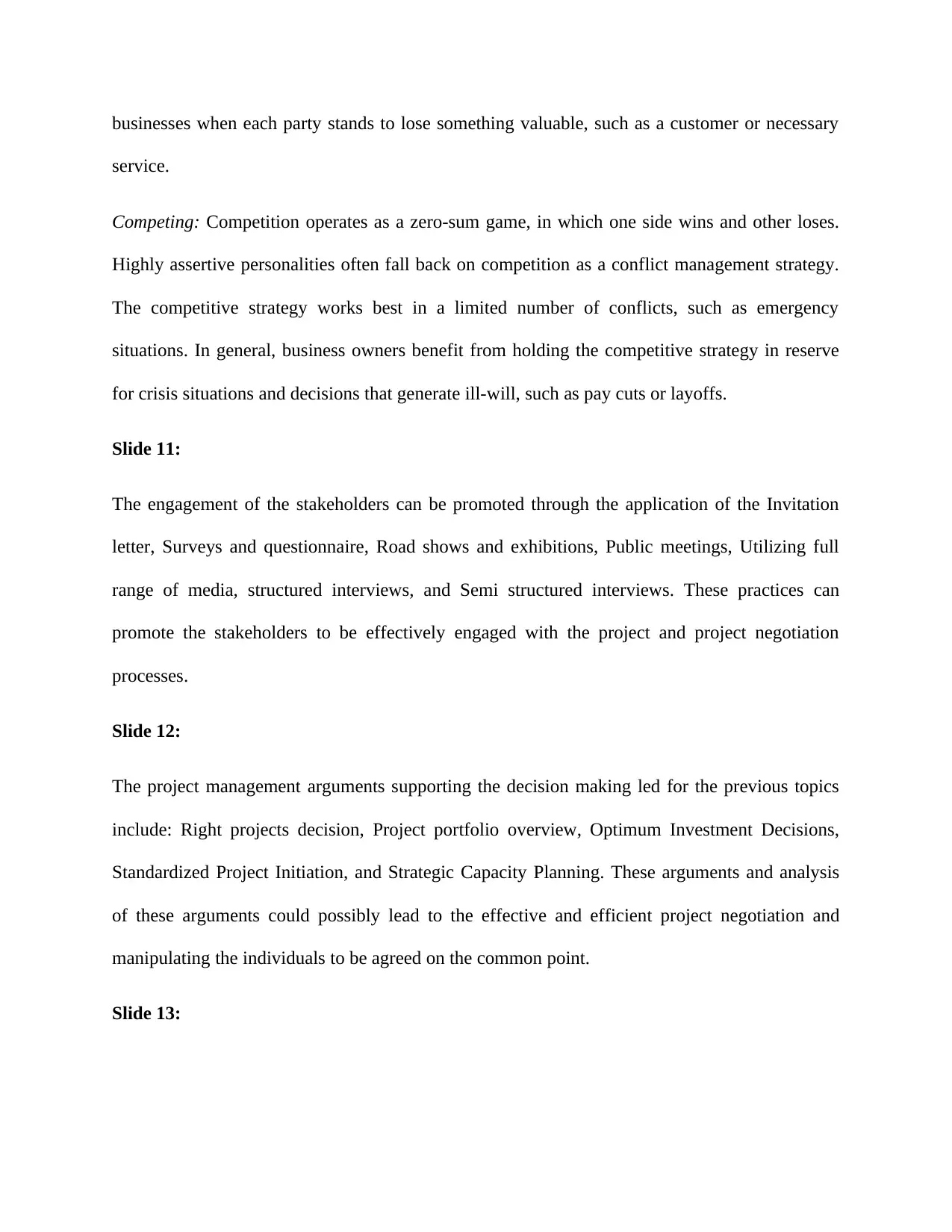Gov & Non-Gov Projects: Negotiation, Conflict & Stakeholder Engagement
VerifiedAdded on 2023/06/12
|7
|1340
|416
Presentation
AI Summary
This presentation delves into project negotiation, conflict management, and stakeholder engagement within diverse government and non-government project contractual arrangements. It analyzes arguments using logic, persuasion, and influence, differentiating methods of project negotiation across projects with differing technology standards and asset lifecycles. The presentation discusses the Channel Tunnel project as an example, highlighting the importance of contractual arrangements and various influencing factors like logic, persuasion, and personal relationships. It further explores conflict management strategies such as accommodating, avoiding, collaborating, compromising, and competing. The presentation concludes by emphasizing stakeholder engagement through various communication methods and project management arguments supporting effective decision-making, ultimately leading to successful project negotiation. Desklib offers a wealth of resources, including past papers and solved assignments, to support students in their academic endeavors.

Speaker Notes
Name of the student
Name of the University
Author Note
Name of the student
Name of the University
Author Note
Paraphrase This Document
Need a fresh take? Get an instant paraphrase of this document with our AI Paraphraser

Slide 2:
The purpose of this presentation is to emphasize on the Project management arguments, theories,
concepts are very crucial aspect in the conflict management and project negotiation. This
presentation discusses. This presentation will cover the topics related to the Diverse and complex
government and non-government Project contractual arrangements including the Logic,
persuasion, and influence factors. This presentation will also cover Methods of project
negotiation, conflict management, and stakeholder engagement and the project management
arguments those could conclude the statements mentioned above.
Slide 3:
Channel Tunnel was also described as a Chunnel that was a 31.35 mi rail tunnel connecting UK
with France and had been designed for the development of the economy and better relationship
among both the countries. The project was not delivered as per the planned way and the Cost was
unexpectedly increased from 5.5 Billion dollars to 14.9 Billion Dollars.
Slide 4:
The contractual arrangements completely depends on the substance of the arrangements among
the entities participating in the project despite of the fact either it is legally binding or not.
Irrespective of the intentions, “the arrangements can be interpreted by a court as being legally
binding if they include some of the elements characteristically found in a legally binding
contract, beyond provisions to share costs, risks, and benefits as explained in this slide.”
Slide 5:
The purpose of this presentation is to emphasize on the Project management arguments, theories,
concepts are very crucial aspect in the conflict management and project negotiation. This
presentation discusses. This presentation will cover the topics related to the Diverse and complex
government and non-government Project contractual arrangements including the Logic,
persuasion, and influence factors. This presentation will also cover Methods of project
negotiation, conflict management, and stakeholder engagement and the project management
arguments those could conclude the statements mentioned above.
Slide 3:
Channel Tunnel was also described as a Chunnel that was a 31.35 mi rail tunnel connecting UK
with France and had been designed for the development of the economy and better relationship
among both the countries. The project was not delivered as per the planned way and the Cost was
unexpectedly increased from 5.5 Billion dollars to 14.9 Billion Dollars.
Slide 4:
The contractual arrangements completely depends on the substance of the arrangements among
the entities participating in the project despite of the fact either it is legally binding or not.
Irrespective of the intentions, “the arrangements can be interpreted by a court as being legally
binding if they include some of the elements characteristically found in a legally binding
contract, beyond provisions to share costs, risks, and benefits as explained in this slide.”
Slide 5:

The above mentioned terminologies explain the operations those are involved in the contractual
agreement between the private and the public organizations. The operations could be many more
than the above mentioned operations however; practically, there are some of the program,
project, portfolio management modalities in manner to enhance the private and public sector
investment in certain; contracts.
Slide 6:
The above mentioned arrangements are usually incorporated within the operations of the non-
government and government contractual arrangements. “It was identified that the topics were
same however; we were entering the conflict management, project negotiation, and stakeholder
engagement and transforming them towards the overall accomplishment and delivery of the
successful; project.” Project constraints need to be managed in an efficient and effective manner
for the successful and precise outcome considering the fulfilment of the objectives and goals of
the project.
Slide 7:
The logical factors for the successful deployment of the project negotiation include the factors
mentioned in this slide that explain the importance of the consideration of these facts.
“Negotiation is a process by which two or more individuals or groups having both common and
conflicting goals state and discusses proposals for the specific terms of a possible agreement.”
The above list is some of the factors influencing g the negotiations while making some
agreements between two parties.
Slide 8:
These are the persuasive factors those are considerable while making a commercial negotiation:
agreement between the private and the public organizations. The operations could be many more
than the above mentioned operations however; practically, there are some of the program,
project, portfolio management modalities in manner to enhance the private and public sector
investment in certain; contracts.
Slide 6:
The above mentioned arrangements are usually incorporated within the operations of the non-
government and government contractual arrangements. “It was identified that the topics were
same however; we were entering the conflict management, project negotiation, and stakeholder
engagement and transforming them towards the overall accomplishment and delivery of the
successful; project.” Project constraints need to be managed in an efficient and effective manner
for the successful and precise outcome considering the fulfilment of the objectives and goals of
the project.
Slide 7:
The logical factors for the successful deployment of the project negotiation include the factors
mentioned in this slide that explain the importance of the consideration of these facts.
“Negotiation is a process by which two or more individuals or groups having both common and
conflicting goals state and discusses proposals for the specific terms of a possible agreement.”
The above list is some of the factors influencing g the negotiations while making some
agreements between two parties.
Slide 8:
These are the persuasive factors those are considerable while making a commercial negotiation:
⊘ This is a preview!⊘
Do you want full access?
Subscribe today to unlock all pages.

Trusted by 1+ million students worldwide

Personal relationship: the relationship between the two parties has been always a considerable
factor for the execution of an effective commercial negotiation.
Fear: the power of the facing individual can also influence the delivery of the commercial
project negotiation and either impact in positive or negative manner.
Mutual obligation: “The memories of good done in the past by the other party also act as an
influence on us.”
Future considerations: “When personal relationships are at stake we may not wish to win the
argument, especially when good relations between the two parties are likely to be affected.”
Slide 9:
Project negotiation includes the mentioned facts and practices those could be adhered for the
effective and efficient communication delivery.
Paraphrase after listening: “This means affirming what the other person is saying by repeating it
back to them. Paraphrasing is very important once the opponent ends his speech.”
Emotional labeling: “This helps to identify the emotions that run through the other person’s
mind and the emotional aspect of the other person can be identified by their actions and words.”
Report Building: the presentation should be attractive ad easy to understand in manner to reflect
on all the aspects of the topics being covered in the project negotiation.
Open Ended Questions and Effective Pauses: “Normally, people tend to speak more while facing
a long silence and are likely to pour out more information and avoid using statements which can
provoke the person you are negotiating with. Provoking their emotions will end up with no
fruitful results from the negotiation.”
factor for the execution of an effective commercial negotiation.
Fear: the power of the facing individual can also influence the delivery of the commercial
project negotiation and either impact in positive or negative manner.
Mutual obligation: “The memories of good done in the past by the other party also act as an
influence on us.”
Future considerations: “When personal relationships are at stake we may not wish to win the
argument, especially when good relations between the two parties are likely to be affected.”
Slide 9:
Project negotiation includes the mentioned facts and practices those could be adhered for the
effective and efficient communication delivery.
Paraphrase after listening: “This means affirming what the other person is saying by repeating it
back to them. Paraphrasing is very important once the opponent ends his speech.”
Emotional labeling: “This helps to identify the emotions that run through the other person’s
mind and the emotional aspect of the other person can be identified by their actions and words.”
Report Building: the presentation should be attractive ad easy to understand in manner to reflect
on all the aspects of the topics being covered in the project negotiation.
Open Ended Questions and Effective Pauses: “Normally, people tend to speak more while facing
a long silence and are likely to pour out more information and avoid using statements which can
provoke the person you are negotiating with. Provoking their emotions will end up with no
fruitful results from the negotiation.”
Paraphrase This Document
Need a fresh take? Get an instant paraphrase of this document with our AI Paraphraser

Being a Projective Thinker: Not allowing room for reactive or proactive actions or thoughts.
Remember, the negotiation takes you to a bright future. Providing so many applications can be
an ineffective approach for the negotiation.
Slide 10:
The conflict management can be accomplished through the demonstrated practices in an
effective and efficient manner.
Accommodating: “The accommodating strategy essentially entails giving the opposing side what
it wants. The use of accommodation often occurs when one of the parties wishes to keep the
peace or perceives the issue as minor.”
Avoiding: the conflicts within the project can be pushed far away through avoiding the conflicts
occurring within the stakeholders while discussing the negotiation processes. “Those who
actively avoid conflict frequently have low esteem or hold a position of low power and in some
circumstances, avoiding can serve as a profitable conflict management strategy, such as after the
dismissal of a popular but unproductive employee.”
Collaborating: Collaboration works through the integration of the ideas contributed by more
than one individual in manner to identify the innovative solution those could be acceptable by
everyone.
Compromising: The compromising strategy typically calls for both sides of a conflict to give up
elements of their position in order to establish an acceptable, if not agreeable, solution. This
strategy prevails most often in conflicts where the parties hold approximately equivalent power.
Business owners frequently employ compromise during contract negotiations with other
Remember, the negotiation takes you to a bright future. Providing so many applications can be
an ineffective approach for the negotiation.
Slide 10:
The conflict management can be accomplished through the demonstrated practices in an
effective and efficient manner.
Accommodating: “The accommodating strategy essentially entails giving the opposing side what
it wants. The use of accommodation often occurs when one of the parties wishes to keep the
peace or perceives the issue as minor.”
Avoiding: the conflicts within the project can be pushed far away through avoiding the conflicts
occurring within the stakeholders while discussing the negotiation processes. “Those who
actively avoid conflict frequently have low esteem or hold a position of low power and in some
circumstances, avoiding can serve as a profitable conflict management strategy, such as after the
dismissal of a popular but unproductive employee.”
Collaborating: Collaboration works through the integration of the ideas contributed by more
than one individual in manner to identify the innovative solution those could be acceptable by
everyone.
Compromising: The compromising strategy typically calls for both sides of a conflict to give up
elements of their position in order to establish an acceptable, if not agreeable, solution. This
strategy prevails most often in conflicts where the parties hold approximately equivalent power.
Business owners frequently employ compromise during contract negotiations with other

businesses when each party stands to lose something valuable, such as a customer or necessary
service.
Competing: Competition operates as a zero-sum game, in which one side wins and other loses.
Highly assertive personalities often fall back on competition as a conflict management strategy.
The competitive strategy works best in a limited number of conflicts, such as emergency
situations. In general, business owners benefit from holding the competitive strategy in reserve
for crisis situations and decisions that generate ill-will, such as pay cuts or layoffs.
Slide 11:
The engagement of the stakeholders can be promoted through the application of the Invitation
letter, Surveys and questionnaire, Road shows and exhibitions, Public meetings, Utilizing full
range of media, structured interviews, and Semi structured interviews. These practices can
promote the stakeholders to be effectively engaged with the project and project negotiation
processes.
Slide 12:
The project management arguments supporting the decision making led for the previous topics
include: Right projects decision, Project portfolio overview, Optimum Investment Decisions,
Standardized Project Initiation, and Strategic Capacity Planning. These arguments and analysis
of these arguments could possibly lead to the effective and efficient project negotiation and
manipulating the individuals to be agreed on the common point.
Slide 13:
service.
Competing: Competition operates as a zero-sum game, in which one side wins and other loses.
Highly assertive personalities often fall back on competition as a conflict management strategy.
The competitive strategy works best in a limited number of conflicts, such as emergency
situations. In general, business owners benefit from holding the competitive strategy in reserve
for crisis situations and decisions that generate ill-will, such as pay cuts or layoffs.
Slide 11:
The engagement of the stakeholders can be promoted through the application of the Invitation
letter, Surveys and questionnaire, Road shows and exhibitions, Public meetings, Utilizing full
range of media, structured interviews, and Semi structured interviews. These practices can
promote the stakeholders to be effectively engaged with the project and project negotiation
processes.
Slide 12:
The project management arguments supporting the decision making led for the previous topics
include: Right projects decision, Project portfolio overview, Optimum Investment Decisions,
Standardized Project Initiation, and Strategic Capacity Planning. These arguments and analysis
of these arguments could possibly lead to the effective and efficient project negotiation and
manipulating the individuals to be agreed on the common point.
Slide 13:
⊘ This is a preview!⊘
Do you want full access?
Subscribe today to unlock all pages.

Trusted by 1+ million students worldwide

The facts explained previously are helpful in concluding that the project negotiations need to be
accomplished through the consideration of the project management practices. Project negotiation
also includes the mix skills including the proper and effective management style that can
motivate the individuals to be agreed on the points being discussed while delivering the project
negotiation.
accomplished through the consideration of the project management practices. Project negotiation
also includes the mix skills including the proper and effective management style that can
motivate the individuals to be agreed on the points being discussed while delivering the project
negotiation.
1 out of 7
Related Documents
Your All-in-One AI-Powered Toolkit for Academic Success.
+13062052269
info@desklib.com
Available 24*7 on WhatsApp / Email
![[object Object]](/_next/static/media/star-bottom.7253800d.svg)
Unlock your academic potential
Copyright © 2020–2025 A2Z Services. All Rights Reserved. Developed and managed by ZUCOL.




